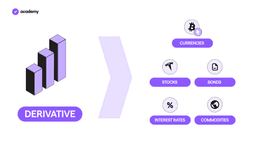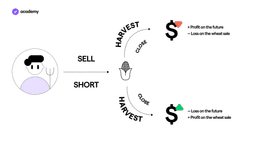Derivatives in Traditional Finance and DeFi
September 27, 2021
7 min

Derivatives are the most popular financial instruments in the traditional market. Decentralised finance gives the opportunity to use them free of intermediaries and without geographical or legal barriers.
What are Derivatives
Derivatives are a type of complex financial instrument. It is a contract between two parties that derives its price from an underlying asset.
In this contract, one of the two parties chooses to profit from the growth of an asset, while the other will profit from the depreciation of the asset.
This underlying instrument is most often a share and a bond, but also a currency, commodity or even an interest rate.
The advantage of a derivative is that you can also profit from the price decrease of the underlying asset, but most importantly it does not require you to physically own assets that might be difficult to manage.
Futures, Forwards and Swaps
The main derivatives you may have heard of are futures and forwards contracts.
These contracts give both parties a certain amount of the underlying asset based on a delivery price and a fixed maturity. As before, one of the two parties bets on the price going up and one bets on it going down.
The difference is that forwards are traded outside regulated markets, whereas futures are standardised and traded on regulated exchanges. Therefore, with futures, it is only possible to choose the price.
Swaps, on the other hand, are contracts regulating the exchange of cash flows or liabilities between two parties, where these liabilities are derived from two different financial instruments. These types of trades take place over-the-counter (OTC), i.e. privately between the two parties, without the supervision of a broker or exchange.
Hedging with derivatives
Hedging is the reduction of risk by offsetting.
Let’s take the example of a farmer who grows wheat. The price of wheat fluctuates in the market like any other commodity, depending on supply and demand.
There is a risk that at harvest time, the price of wheat will fall, making it unprofitable to sell it.
To compensate for this risk, the farmer can short a wheat futures contract for the amount he expects to harvest. In other words, he bets on the depreciation of the wheat.
At harvest time, the farmer closes his position.
If the price of wheat falls, the farmer receives a profit from the futures. In this way he has compensated for the potential loss of profit due to the market.
On the other hand, if the price of wheat goes up, the farmer has lost the futures bet, but gains by selling his crop, thanks to a high market price.
This not only avoids particularly difficult years, but also makes business more predictable.
Speculation with derivatives
Derivatives make it easy to speculate on the price of assets that in their original form would be complex to manage, such as gold or oil.
In addition, derivatives allow you to use leverage. Leveraged investing is only possible with a broker and is a very risky way of trading.
Leverage requires the trader to pay a fraction of the market position to which they actually want to be exposed. Liquidity for the remaining portion of the position will be provided by the broker.
The profit or loss, however, will be based on the entire position, not just the amount the trader has paid in. This means that once the position is closed, they will make or lose a much higher percentage of what they have spent. In this case more than ever, maximum gain means maximum risk.
Derivatives in DeFi
Whether derivatives are traded over-the-counter (OTC) or on exchanges, traditional derivatives require a trusted intermediary to oversee the contractual relationship.
This implies that access to this type of asset depends on the regulator of the state where you live and the policies of the financial institutions operating in this sector.
Derivatives are a key piece of DeFi‘s alternative financial offering. In fact, it is estimated that the total market for traditional derivatives is worth at least a quadrillion dollars, and would be the largest market in the world.
For this reason and to offer the use cases of hedging and speculation, the crypto and DeFi industry is well advised to develop this type of market.
Derivatives on blockchain require 3 main technological elements to support them:
- Smart contracts, as for any decentralised application.
- Oracles, to be able to receive real-time information on the prices of the underlyings.
- Tokenisation, i.e. making the derivative a blockchain-compatible, fungible and programmable token.Derivatives in the form of tokens on the blockchain are called synthetic assets.
Consequently, synthetic assets can only be developed on blockchains that offer these 3 functionalities in an efficient and scalable way.
There are several protocols that allow synthetic assets to be created, traded and also used for Yield Farming. The most popular ones are Mirror and Synthetix.
Synthetix: how it works
Synthetix is a protocol on the Ethereum blockchain that enables trading in synthetic assets. The token that powers the protocol is Synthetix Network Token (SNX), an ERC-20.
The Synthetics model is based on a debt pool. In order to issue a synthetic asset, collateral must be deposited in SNX for 500% of the amount to be generated.
So if I deposit €500 of SNX in the pool, I will get €100 of synthetic assets.
Each of these assets is an ERC-20 token that reflects the price of various traditional assets, which can be commodities such as gold, as well as fiat currencies or cryptocurrencies.
On Synthetix, synthetic assets can be traded with each other, or used on other Ethereum protocols such as Uniswap or Yearn Finance.
With the highest total value locked of all DeFi derivative protocols, Synthetix was one of the first protocols launched on Optimism, Ethereum’s Layer 2.





